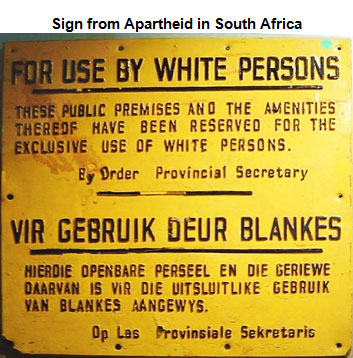
Throughout history, other political systems have surfaced around the world. Read below to learn more.
An oligarchy is the rule of government by a few people. The few who are in control rule for corrupt or selfish reasons. An example of an oligarchy in world history is the political system in 20th century South Africa.
After centuries of colonization by European countries, black South Africans were forced to live in a society where they had no political rights and were racially segregated from the whites who were fewer in number but held all of the political authority. Whites passed more than 300 apartheid laws that further restricted the rights of blacks while giving the whites political and social domination.

Click the link below and watch the following video about the effects of apartheid on South Africa’s schools. Answer the questions that follow.
![]() Apartheid Haunts South Africa's Schools
Apartheid Haunts South Africa's Schools
→ Why are South African schools still failing after apartheid?
Interactive popup. Assistance may be required.
Due to the segregation of apartheid, black teachers were educated in an inferior education system. Therefore, they are unable to provide their students with an adequate education, one that would lead them out of poverty.
Totalitarianism is another form of government that is important in world history. Totalitarianism is the political system in which the government controls all aspects of the lives of the citizens.
World War II was a period in history that saw a rapid and dramatic rise in totalitarian governments. A dictator, the leader of the only political party, usually leads this political system. In a totalitarian government, the needs of the individual are ignored, as the needs of the country are put first.
Click on the image of Adolf Hitler below to learn more about his totalitarian government.

The opposite of totalitarianism, democracy is a political system in which the political authority is derived from the people. The rights of the individual are paramount.
Democracy is most closely associated with the government of the United States, but the Ancient Greeks were the first to institute this form of government. Democracy was also the form of government of ancient Rome. This form of government has evolved throughout history. As people sought more freedom and political power from their governing bodies, democracy was at the root of many of the revolutions that took place.
The American Revolution was based on the desire for American colonists to have individual freedoms and the ability to govern themselves. Since the time of the American Revolution, the United States has served as a model for democracy. Democracy is a powerful political force in many parts of the world.
At the end of World War II, the United States found itself in the Cold War with Russia, a communist foe. The Cold War divided Europe. Democratic countries supported the United States, while other countries fell under the control of the Soviet Union. This rivalry of political ideologies lasted until the 1990s. One of the lasting symbols of this political division was the Berlin Wall.
Click on the link to watch the following video and learn more about the deconstruction of the Berlin Wall. Answer the questions that follow.
Interactive popup. Assistance may be required.
The Berlin Wall was constructed to divide East and West Berlin in Germany and to keep East Berliners in Soviet-controlled Germany.
Interactive popup. Assistance may be required.
The Berlin Wall did not prevent East Berliners from crossing over. Some jumped from windows or drove straight through barriers.
Interactive popup. Assistance may be required.
The Berlin Wall was torn down in 1990.
The destruction of the Berlin Wall signified the end of the division between democracy and communism in Germany. Germany was later unified and has since become a democracy with a government based on a constitution.
In this lesson, you have learned about some of the political systems in world history. This exercise will help you review the characteristics and events associated with these political systems.
![]() Read the following statements about political systems. Click on the correct system that the statement describes.
Read the following statements about political systems. Click on the correct system that the statement describes.
Sources of images used for this section as they appear, top to bottom: